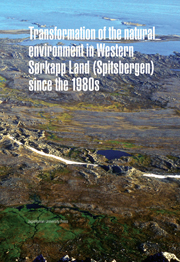Landscape research
from Methods and materials
Published online by Cambridge University Press: 05 September 2014
Summary
Complex landscape field mapping at a scale of 1 : 25 000 was the basic method of surveying the study area in the 1980s. A total of 1,514 small basic landscape units (so-called geocomplexes of the uroczysko range) were mapped across an area of ca. 94 km2. An old Norwegian topographic map at a scale of 1 : 100 000 (Sørkapp sheet), current for 1936 and enlarged fourfold, was used as a base map. Each individual landscape unit was drawn on the map, numbered and described on a special separate form. The demarcation criteria consisted of spatial changes in environmental and landscape features. The following characteristics were analyzed: elevation, slope gradient and exposure, lithostratigraphy, tectonics (dip of the rock strata), Quaternary deposits (genesis, granulation, thickness), morphogenesis, micro-relief, geomorphic processes, meso-climate (based on exposure, shadowing and persistence of snow patches), bodies of water and vegetation (density and composition, division into vascular plants, mosses and lichens). The mapping covered virtually all of the area that had not been covered by glaciers during the Holocene in western Sørkapp Land. The landscape units were grouped into several dozen types, which made it possible to create detailed maps of the landscape structure of the area (Czeppe, Ziaja 1985; Kuczek, Ziaja 1990; Ziaja 1991, 1992).
- Type
- Chapter
- Information
- Transformation of the Natural Environment in Western Sorkapp Land (Spitsbergen) since the 1980s , pp. 17 - 20Publisher: Jagiellonian University PressPrint publication year: 2011

